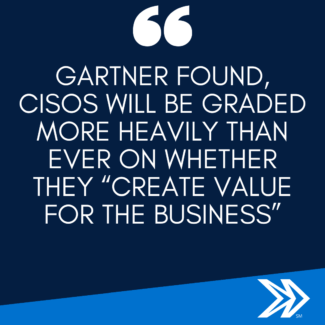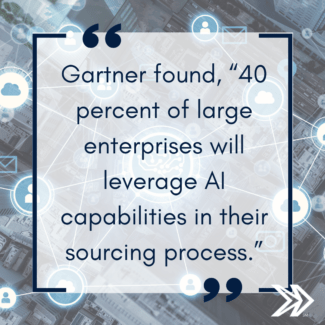May 6, 2021
Titled “Top Priorities for IT: Leadership Vision for 2021,” the latest version of Gartner’s annual IT industry report is chock-full of useful insights and statistics. Encompassing roles ranging from CIOs and Heads of IT to SPVM leaders, it addresses key challenges, trends and actions for each group. At more than 50 pages, though, it’s no breezy read. Here’s a summary to save you some time.
CIOs and Heads of IT
The widespread shift to remote work necessitated by COVID-19 proved them right: companies need to take much fuller advantage of technology to accelerate business operations moving forward. “By 2024,” Gartner found, “25 percent of traditional large enterprise CIOs will be held accountable for digital business operational results, effectively becoming ‘COO by proxy.’” Trends include: a continued increase in online business activity; the remodeling of core technologies like AI and RPA; a movement toward increased supply chain resilience. Challenges include: Rightsizing support for remote and hybrid work; Digital business acceleration. Actions to take include: Making small but meaningful changes so the organization can shift more nimbly in the face of future disruptions; Working with boards/CEOs to increase funding for digital acceleration.
Security and Risk Management Leaders
Gartner found that “only 12 percent of CISOs are able to exceed the expectations of leadership” when it comes to four main tasks: leading the function; organizing security service delivery; embedding governance in workflows; and influencing strategic decision-makers. But that needs to change. In the next couple of years, Gartner found, CISOs will be graded more heavily than ever on whether they “create value for the business”.
Trends include: The acceleration of “citizen computing” using development and run-time environments approved by IT; Increased cyber risk from new digital initiatives; More widespread implementation of cybersecurity mesh to extend security policy to external digital assets. Challenges include: Insufficient cybersecurity investment to cover digital acceleration; A dearth of skilled cybersecurity experts who are familiar with new technology. Actions include: CISOs should shift from a building and operation approach to one that incorporates facilitating, enabling and ensuring; Cybersecurity talent should be hired based on traits like adaptability and digital dexterity, and developed in-house.
Application Leaders
It used to be that getting buy-in for new digital applications from those who controlled the purse strings was an uphill battle. Now it’s the opposite: buy-in is quicker than ever but adaption lags behind. Within the next year or so, Gartner predicts, “organizations with diverse IT-business collaborations will deliver business outcomes 25 percent faster than their competitors.” Trends include: The democratization of technology, with end-users becoming tech producers; Better applications that drive business outcomes; Now-common hybrid model of on-prem and cloud is driving the need for new frameworks, methods and tools. Challenges include: Becoming more agile to better deal with future IT disruptions on the scale of COVID-19; Improving business outcomes by making the remote workforce even more “digitally dextrous.” Actions include: “Align[ing] talent more closely with business value streams”; Increasing investment in customer data analytics to deliver a better customer experience.
Program and Portfolio Management Leaders
These include PMOs, EPMOs and SROs. The pandemic has placed a premium on digital business practices and rapid transformation. As a result, those who occupy these traditionally staid roles have had to become far more adaptive and nimble. “By 2024,” Gartner found, “50 percent of all PPM leaders will integrate complementary technologies to enable portfolio decision-making and modern work management for digital business evolution.” Trends include: “Shifting from a command-and-control mentality to a change enablement mindset;” Taking a more flexible “adaptive” approach rather than a directive one; Streamlining oversight, governance and portfolio management to become more agile and create greater value. Challenges include: Supporting an organization’s potential paths forward by adjusting accordingly; The introduction of new methods and practices like work-from-home and data centricity to prepare for future disruptions. Actions include: Working with human resources to hire the right talent from a currently shallow pool; Leveraging AI and RPA tech to simplify and lighten workloads of managers and other team members.
Data and Analytics Leaders
As ever, these folks have their work cut out for them as they continue to find ways to create “repeatable, sustainable value” for companies that have invested lots of money in data and tech but seen only modest or weak ROI in return. “By 2023,” Gartner predicts, “data literacy will become an explicit and necessary driver of business value, demonstrated by its formal inclusion in over 80 percent of data and analytics strategies and change management programs.” Additionally, nearly a third of CDOs will work more closely with CFOs to “formally value [an] organizations information assets for improved information management and benefits.” Trends include: Embedding D&A in business strategy; Improving data literacy to better inform decisions; Raising D&A’s profile within a company and making it more inclusive. Challenges include: Greater integration of D&A with overall business strategy; D&A leaders need to become less IT-centric and more collaborative with COOs and CEOs. Actions include: Focusing on “creating a data-driven culture, developing a data and analytics strategy and standing up a data-information governance program”; Implementing adaptive D&A governance to improve business impact.
Infrastructure and Operations Leaders
Infrastructure-led innovation is key, and nearly three-quarters of companies that don’t make that shift will find themselves out of the loop and on the margins by 2025. Trends include: Customer value trumps infrastructure reliability; I&O leaders are increasingly hired based on their experience creating customer value and overall corporate vision; More investment in skills like DevOps, product management and agile. Challenges include: Finding and filling skill gaps; Lowering “technical debt” in order to more effectively innovate. Actions include: “Inspire and engage” rather than dictate and demand; Strive for a better balance between “cost management and net new investment.”
Enterprise Architecture Leaders
Seeing as “60 percent of organizations will depend on EAs to lead the business approach to innovation” by 2023, it’s imperative that EA leaders develop a three-year plan to deliver “high-impact” advice that delivers key business outcomes. Trends include: Playing a vital role in COVID-19 recovery by finding “innovative ways to reduce cost, increase productivity and drive better performance”; More focus on and involvement with business strategy; Assisting execs in finding ways to effectively incorporate more AI-based solutions. Challenges include: Clearer messaging on the nature of EA and educating key stakeholders on its value; Shifting deliverables from IT-centric to business-centric. Actions include: Adopting a more adaptive and nurturing leadership style; Developing a more flexible EA team that encompasses key parts of the business.
 Sourcing, Procurement and Vendor Management Leaders
Sourcing, Procurement and Vendor Management Leaders
“By 2024,” Gartner found, “40 percent of large enterprises will leverage AI capabilities in their sourcing process.” Enter SPVM leaders, whose focus on cost optimization and facilitating the ongoing shift to digital business was kicked into high gear by COVID-19. Their responsibilities, Gartner’s report suggests, include four operating models: “Execute, consult, advise and enable self-service.” Trends include: A shift toward cost optimization over cost cutting by streamlining processes and getting rid of redundancies; Helping to guide the pandemic-spurred shift to digital; A reinvention of the SPVM role to add more value in an increasingly self-service environment. Challenges include: Pivoting rapidly in response to shifting economic conditions; Optimizing costs via enhanced purchase visibility and “controlled self-service.” Actions include: Make cost management “a continuous and relentless focus”; Develop an “agile procurement framework” to support the more rapid implementation of digital initiatives.
Much has been learned from 2020. IT leaders shifted entire organizations in record time to working remotely while ensuring environments were secure. We made many strides and learned many lessons – the hard way. Despite an incredibly challenging year, and as this Gartner report points out, many opportunities exist to transform business operations and models so that we’re more strategically prepared for future disruptions.
About Mindsight
Mindsight is industry recognized for delivering secure IT solutions and thought leadership that address your infrastructure and communications needs. Our engineers are expert level only – and they’re known as the most respected and valued engineering team based in Chicago, serving emerging to enterprise organizations around the globe. That’s why clients trust Mindsight as an extension of their IT team.
Visit us at http://www.gomindsight.com.
 Sourcing, Procurement and Vendor Management Leaders
Sourcing, Procurement and Vendor Management Leaders